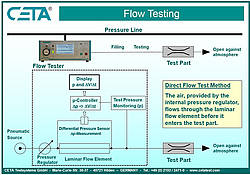Flow Test
Flow tests using compressed air require a laminar flow through the test part. Examples for typical test parts are pipes (e.g. brake pipes, oil pipes, cooling pipes), valves (e.g. metering valves) and membranes, which have to be tested for definite flows.
A complete measurement cycle of a flow test consists of the filling and the testing phase. The air flows constantly through the test part. Therefore the test phase can start directly after the test pressure has been reached. In the illustration the direct flow test method is shown: The air, provided by the internal pressure regulator, flows through the laminar flow element before it enters the test part. The test part is open against atmosphere. In the indirect flow test method the laminar flow element is located behind the test part. Due to the special design of the laminar flow element a laminar flow is generated. In a laminar flow the pressure difference between the measuring points is directly proportional to the volume flow.
The pressure difference is registered by a differential pressure sensor and converted into a volume flow. If a specific flow range has to be covered a suitable type of laminar flow element has to be used.
The flow test is performed by the use of compressed air. In practical applications fluids (e.g. water, oil) flow through the test part. For the corresponding fluid flow a material specific conversion, taking into account the dynamic viscosities, has to be done.
In many cases the test procedure should detect good and bad parts based on a flow test using air. The flow value registered in the testing phase is compared to the evaluation limits. If the measured flow is within these limits the test part is evaluated as good part.



